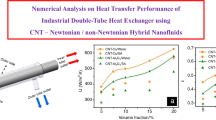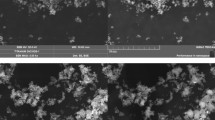Abstract
An experimental investigation on the influence of hybrid nanofluids (HNFs) on heat transfer and flow performance of a heat exchanger tube is presented in this paper. A custom-made thermo-hydraulic loop containing a 1200 mm long copper tube with 12 mm internal diameter is used for the present purpose. The tube was exposed to a constant heat flux of 4530 W m−2. Water-based novel HNFs of SiO2-MgO, SiO2-ZnO, SiO2-TiO2 and SiO2-ZrO2 at 0.05 mass % and pure Deionized (DI) water are used as working fluids. The test-fluids are fed into the loop at a varying mass flow rate from 0.03 to 0.27 kg s−1. Significant enhancement in heat transfer of the tube is obtained with the HNFs when compared to DI-water. The heat transfer performance is enhanced up to 94% with the application of HNFs. The SiO2–MgO exhibits the best heat transfer performance as compared to the other HNFs. The SiO2-ZrO2 HNF shows the worst performance, even worse than DI-water. The rise in friction factor caused by HNFs is identical and very limited as compared to DI-water. Finally, thermo-hydraulic performance of HNFs is analyzed by drawing Figure of Merit (FOM). Based on the FOM analysis, an optimum flow rate of 0.13 kgs−1 and SiO2–MgO HNF are recommended for future heat transfer applications.






Similar content being viewed by others
Data availability
The data that support the findings of this study are available from the corresponding author upon reasonable request.
Abbreviations
- A c :
-
Area of cross section/m2
- A s :
-
Surface area of tube/m2
- D :
-
Diameter of the tube/m
- r :
-
Radius of the tube/m
- L :
-
Length of the tube/m
- T in :
-
Inlet temperature/K
- T out :
-
Outlet temperature/K
- T b :
-
Bulk temperature/K
- C p :
-
Specific heat/J kg−1 K−1
- Q :
-
Heat transfer rate/W
- q :
-
Heat flux/W m−2
- ṁ :
-
Mass flow rate/kg s−1
- h :
-
Heat transfer coefficient/W m−2 K−1
- Nu:
-
Nusselt number
- Re:
-
Reynolds number
- Pr:
-
Prandtl number
- k:
-
Thermal conductivity/W m−1 K−1
- f:
-
Friction factor
- Dh :
-
hydraulic diameter/m
- \(\varphi\) :
-
Concentration
- \(\mu\) :
-
Viscosity/Pa s
- \(\rho\) :
-
Density/Kg m−3
- bf:
-
Base fluid
- HNF:
-
Hybrid nanofluid
- m:
-
Mass
- vol:
-
Volume
- np:
-
Nanoparticle
References
Ahmed F, Khanam A, Samylingam L, Aslfattahi N, Saidur R, et al. Assessment of thermo-hydraulic performance of MXene-based nanofluid as coolant in a dimpled channel: a numerical approach. J Therm Anal Calorim. 2022;147(22):12669–92.
Apmann K, Fulmer R, Scherer B, Good S, Wohld J, Vafaei S, et al. Nanofluid heat transfer: enhancement of the heat transfer coefficient inside microchannels. Nanomaterials. 2022;12(4):615.
Sun Y, Yang D, Shi L, Wu H, Cao Y, He Y, **e T, et al. Properties of nanofluids and their applications in enhanced oil recovery: a comprehensive review. Energy Fuels. 2020;34(2):1202–18.
Nada SA, El-Zoheiry RM, Elsharnoby M, Osman OS, et al. Enhancing the thermal performance of different flow configuration minichannel heat sink using Al2O3 and CuO-water nanofluids for electronic cooling: An experimental assessment. Int J Therm Sci. 2022;181:107767.
Mandal DK, Biswas N, Manna NK, Gorla RSR, Chamkha AJ, et al. Hybrid nanofluid magnetohydrodynamic mixed convection in a novel W-shaped porous system. Int J Numer Methods Heat Fluid Flow. 2023. https://doi.org/10.1108/HFF-03-2022-0163.
Huq T, Ong HC, Chew BT, Leong KY, Newaz KS et al. Review on aqueous graphene nanoplatelet nanofluids: preparation, stability, thermophysical properties, and applications in heat exchangers and solar thermal collectors. Appl Therm Eng. 118342.
Ma M, **e M, Ai Q, et al. Simulation on influences of Al2O3 nanofluids as coolant for nuclear power plant based on modified empirical formula of nanofluids thermal properties at high temperature and high pressure. Energy Sour, Part A: Recov, Util, Environ Eff. 2022;44(1):454–68.
Arora N, Gupta M, Katyal P, et al. Experimental investigation on heat transfer and flow characteristics of MgO/water nanofluids in a flat tube. Mater Today: Proc. 2022;69:227–34.
Darbari AM, Alavi MA, Saleh SR, Nejati V, et al. Sensitivity analysis of nanofluid flow over different flat tubes confined between two parallel plates using Taguchi method and statistical analysis of variance. Int J Therm Sci. 2022;173:107428.
Sheikholeslami M, Jafaryar M. Thermal assessment of solar concentrated system with utilizing CNT nanoparticles and complicated helical turbulator. Int J Therm Sci. 2023;184: 108015.
Aljabair S, et al. Numerical and experimental investigation of heat transfer enhancement by hybrid nanofluid and twisted tape. Eng Technol J. 2022;41(1):69–85.
Shibata A, Fujimoto K, Torii S, et al. Heat transfer enhancement of graphene nanofluid manufactured from graphite sheet. Mater Today: Proc. 2022;66:1852–7.
Chummar A, Harish R, et al. Numerical investigation of forced convective heat transfer of nanofluids within an enclosure. Mater Today: Proc. 2022;51:1465–72.
Talebian R, Talebi M, et al. An experimental study on pressure-drop of CNT/water nanofluid in triple-tube heat exchanger. J Comput Appl Res Mech Eng (JCARME). (2023). https://doi.org/10.22061/jcarme.2022.8582.2150
Li G, Wang J, Zheng H, **e G, Sundén B, et al. Improvement of cooling performance of hybrid nanofluids in a heated pipe applying annular magnets. J Therm Anal Calorim. 2022;147(7):4731–49.
Thansekhar MR, Anbumeenakshi C, et al. Experimental investigation of thermal performance of microchannel heat sink with nanofluids Al2O3/water and SiO2/water. Exp Tech. 2017;41(4):399–406.
Sieder EN, Tate GE, et al. Heat transfer and pressure drop of liquids in tubes. Ind Eng Chem. 1936;28(12):1429–35.
Blasius H, et al. Grenzschichten in flüssigkeitenmitkleinerReibung. Inaugural-Dissertation, von H. Blasius. Druck von BG Teubner, Göttingen.
Gaikwad SN, Surwase DM, et al. Effects of thermodiffusion on Darcy-Brinkman convection in a rotating binary nanofluid saturating a porous layer. Can J Phys. 2022;100(4):226–36.
Mohammed K, Saleem A, et al. Numerical investigation of Nusselt number for nanofluids flow in an inclined cylinder. Front Heat Mass Transfer (FHMT). 16.
Bhatti MM, Rashid A, Zeeshan A, et al. Experimental investigation of thermal conductivity and stability of ZrO2-H2O nanofluids. Results Phys 12: 2159–2167.
Khanafer K, Vafai K, Lightstone M, et al. Buoyancy-driven heat transfer enhancement in a two-dimensional enclosure utilizing nanofluids. Int J Heat Mass Transf. 2003;54(5–6):974–83.
Riazi R, Li X, Al-Nimr MA, et al. Experimental investigation of heat transfer characteristics of ZrO2–water nanofluid. Appl Therm Eng. 2013;59(1–2):249.
Bellos E, Tzivanidis C, et al. Multi-criteria evaluation of a nanofluid-based linear Fresnel solar collector. Sol Energy. 2018;163:200–14.
Karami M, Sheikhzadeh GA, Amiri A, et al. Numerical simulation of natural convection of CuO–water nanofluid in a semi-annulus enclosure using LBM. Int J Therm Sci. 60: 1–13.
Acknowledgements
The authors are thankful to Thermal Research Laboratory (TRL) of School of Mechanical Engineering of KIIT Deemed to be University, India, Kuwait University and Kuwait Institute for Scientific Research (KISR), Kuwait for their support and cooperation in this study.
Author information
Authors and Affiliations
Corresponding author
Ethics declarations
Conflict of interest
The authors do not share any conflict of interests.
Additional information
Publisher's Note
Springer Nature remains neutral with regard to jurisdictional claims in published maps and institutional affiliations.
Rights and permissions
Springer Nature or its licensor (e.g. a society or other partner) holds exclusive rights to this article under a publishing agreement with the author(s) or other rightsholder(s); author self-archiving of the accepted manuscript version of this article is solely governed by the terms of such publishing agreement and applicable law.
About this article
Cite this article
Poloju, V.K., Mukherjee, S., Mishra, P.C. et al. Efficient convective heat transfer enhancement in heat exchanger tubes with water based novel hybrid nanofluids: experimental investigation. J Therm Anal Calorim 148, 7869–7879 (2023). https://doi.org/10.1007/s10973-023-12251-9
Received:
Accepted:
Published:
Issue Date:
DOI: https://doi.org/10.1007/s10973-023-12251-9




